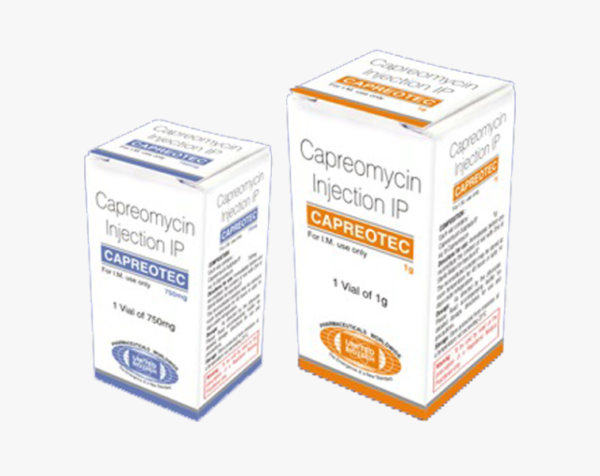Capreomycin is an injectable medicine used in the treatment of multidrug-resistant tuberculosis as a second line therapy. It is used in combination with other agents (like isoniazid, rifampin, ethambutol, and pyrazinamide) for the treatment of capreomycin-susceptible strains of Mycobacterium tuberculosis.
Capreomycin dose in Adults
Capreomycin use in the treatment of pulmonary Tuberculosis:
- 15 mg/kg Intramuscularly or intravenously once daily at a dose of up to 1 g for 5–7 days a week for 2–4 months, then 15 mg/kg twice or three times per week.
Capreomycin Dose in Children
Second-line medication for the treatment of active TB infections that are multidrug resistant (MDR).
Note: It should be added to a multidrug regimen. Consult experts prior to initiating therapy and follow relevant guidelines.
For the treatment of Primary pulmonary disease:
- Once a day therapy Infants, Children, and Adolescents less than 15 years and weighing 40 kgs or less:
- 15 to 30 mg/kg/dose Intramuscular or intravenous once a day.
- An initial dose range of 15 to 20 mg/kg/dose once a day to a maximum dose of 1,000 mg/day has been advised by some experts.
- Children and Adolescents less than 15 years weighing more than 40 kgs or Adolescents 15 years or more:
- Daily administration:
- 15 mg/kg/dose Intramuscular or intravenous once a day to a maximum dose of 1,000 mg/day. Serum concentration should be monitored.
- Three-times weekly DOT therapy:
- 25 mg/kg/dose Intramuscular or intravenous three times weekly to a maximum dose of 1,000 mg/dose.
- Twice-weekly DOT:
-
- Infants, Children, and Adolescents less than 15 years and weighing 40 kgs or less:
- 25 to 30 mg/kg/dose Intramuscular or intravenous twice a week to a maximum dose of 1,000 mg/dose.
- 25 to 30 mg/kg/dose Intramuscular or intravenous twice a week to a maximum dose of 1,000 mg/dose.
- Infants, Children, and Adolescents less than 15 years and weighing 40 kgs or less:
-
- Daily administration:
Meningitis caused by Mycobacterium Tuberculosis (independent of HIV-status):
- 15 to 30 mg/kg/dose Intramuscular or intravenous once a day.
- May use 15 to 20 mg/kg/dose once a day to a maximum daily dose of 1,000 mg/day.
- Monitor serum concentrations.
Pregnancy Risk Factor C
- [US Boxed Warn]: Safety for pregnant womenIt has not been established.
- Capreomycin should be avoided during pregnancy due to the possibility of congenital hearing loss and fetal nephrotoxicity.
Capreomycin use during breastfeeding:
- Nursing mothers should use it with caution. It is not known if it will be excreted into breastmilk.
Capreomycin Dose in Renal Disease:
Dose adjustment according to the Manufacturer's labeling (maximum dose: 1 g/dose):
- CrCl 110 mL/minute: 13.9 mg/kg one time a day
- CrCl 100 mL/minute: 12.7 mg/kg one time a day
- CrCl 80 mL/minute: 10.4 mg/kg one time a day
- CrCl 60 mL/minute: 8.2 mg/kg one time a day
- CrCl 50 mL/minute: 14 mg/kg every other day or 7 mg/kg once a day
- CrCl 40 mL/minute: 5.9 mg/kg or 11.7 mg/kg every other day, whichever comes first
- CrCl 30 mL/minute: 4.7 mg/kg once per day, 9.5 mg/kg each alternate day, or 14.2 mg/kg each subsequent day.
- CrCl 20 mL/minute: One dose of 3.6 mg/kg each day, two doses of 7.2 mg/kg, and three doses of 10.7 mg/kg.
- CrCl 10 mL/minute: 2.4 mg/kg once daily, 4.9 mg/kg twice daily, or 7.3 mg/kg three times each week.
- CrCl 0 mL/minute: Once daily at 1.3 mg/kg, twice daily at 2.6 mg/kg, and three times daily at 3.9 mg/kg.
Capreomycin Dose in Liver Disease:
The manufacturer has not recommended any dose adjustment in patients with liver disease.
Common Side Effects Of Capreomycin Include:
- Otic:
- Ototoxicity
- 2.4 mg/kg once daily, 4.9 mg/kg twice daily, or 7.3 mg/kg three times each week.Genitourinary:
- Nephrotoxicity
Less Common Side Effects Of Capreomycin Include:
- Hematologic:
- Eosinophilia
Contraindication to capreomycin include:
- Allergy reactions to capreomycin and any other component of the formulation
Warnings & Precautions
- Electrolyte imbalance:
- Hypocalcemia, hypokalemia and hypomagnesemia may occur.
- During treatment, electrolytes should always be monitored.
- Nephrotoxicity:
- Capreomycin can cause renaltoxicity. This includes tubular necrosis and elevated serum creatinine or BUN.
- Before and during treatment, monitor your renal function.
- If the patient experiences a rise in creatinine, BUN, or any other indication of reduced renal function, it is important to adjust or withhold therapy.
- Ototoxicity:
- Capreomycin therapy may be used to treat vestibular dysfunction and ototoxicity that is irreversible due to impairment of the VIII cerebral nerve.
- Therapy should include periodic audiometric assessments and vestibular function assessments.
- Superinfection
- Capreomycin treatment for longer periods (over 2 months) can lead to superinfections, including fungal or bacterial superinfections. C. difficile-associated diarrhea, (CDAD), and pseudomembranous collitis can occur.
- Auditory impairment [US Boxed Warning]
- Patients with an existing hearing impairment should be advised to take the drug with extreme caution.
- Renal impairment [US Boxed Warning]
- Preexisting renal dysfunction patients should be cautious when using it. Patients with kidney failure should adjust the dose.
Capreomycin: Drug Interaction
Note: Drug Interaction Categories:
- Risk Factor C: Monitor When Using Combination
- Risk Factor D: Consider Treatment Modification
- Risk Factor X: Avoid Concomitant Use
Risk Factor C (Monitor therapy). |
|
| Aminoglycosides | Capreomycin may enhance the neuromuscular-blocking effect of Aminoglycosides. |
| BCG Vaccine (Immunization) | Antibiotics can decrease the therapeutic effects of BCG Vaccine (Immunization). |
| Colistimethate | Capreomycin may enhance the neuromuscular-blocking effect of Colistimethate. |
| Lactobacillus & Estriol | Antibiotics can reduce the therapeutic effects of Lactobacillus or Estriol. |
| Neuromuscular-Blocking Agents | Capreomycin may enhance the neuromuscular-blocking effect of Neuromuscular-Blocking Agents. |
| Polymyxin B | The neuromuscular-blocking effects of Polymyxin B may be strengthened by capreomycin. |
Risk Factor D (Think about therapy modification) |
|
| Sodium Picosulfate | Antibiotics can reduce the therapeutic effects of Sodium Picosulfate. Patients who are currently using or have just finished using antibiotics should consider using an alternative product to cleanse the bowel before undergoing a colonoscopy. |
Risk Factor X (Avoid Combination) |
|
| BCG (Intravesical). | The therapeutic effects of BCG (Intravesical) may be diminished by antibiotics |
| Cholera Vaccine | Cholera Vaccine may be less effective if taken with antibiotics. Treatment: Cholera vaccine should be avoided in patients who have received systemic antibiotics. |
| Mecamylamine | Capreomycin may enhance the neuromuscular-blocking effect of Mecamylamine. |
Monitoring parameters:
- Vestibular function and Audiometric measurements at baseline and periodically during therapy
- Renal function tests at baseline and once a week during therapy
- Serum electrolytes at baseline (including calcium, magnesium, and potassium) and periodically thereafter.
- Liver function tests at baseline and as needed during therapy.
How to administer capreomycin?
Intramuscular injection:
- Give a deep intramuscular injection into a sizable amount of muscle.
- If administered intravenously, it should be slowly infused over one hour.
Mechanism of action of capreomycin:
- Capreomycin, a cyclic polypeptide antibiotic that can be used to treat mycobacterial infections that are sensitive to capreomycin, is known as Capreomycin.
- Its mechanism of action remains a mystery. Cross-resistance is a significant problem with viomycin and kanamycin as well as neomycin.
It isn'tabsorbedWhen taken orally.
When taken via the oral route. half-life eliminationPatients with normal renal function will take between 5 and 6 hours. Half-life elimination for patients with CrCl 50-80 mL/minute is 7-10 hours. For CrCl 20-40 mL/minute or less, it's 29 hours. After an event, it takes between 1 and 2 hours.IntramuscularInjection to reach thepeak serum concentration. 52 % of the drug can be excreted unchanged by urine.
International brands of Capreomycin:
- Capacin
- Capastat
- Kapocin
Capreomycin Brands in pakistan:
No brands available in the market in Pakistan. May be available in WHO specialized centres for the treatment of MDR TB.




